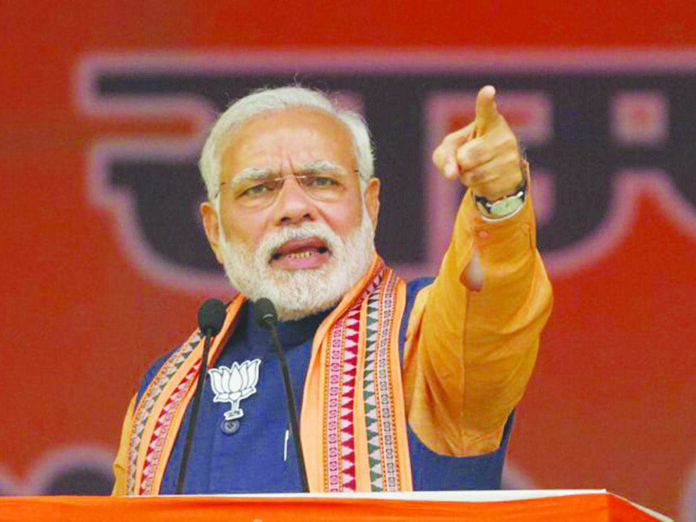AT PENPOINT
The Indian election is not a quick one-day exercise with the result virtually clear by the wee hours of the night after. It is an exercise that lasts more than a month. It is a huge lumbering journey across India. By paying attention to the various phases. One can learn an amazing amount about the subcontinent. That was one of the most prominent benefits, for the huge exercise, in which nearly a billion voters were involved, yielded what might seem a boring result. The BJP has been returned to office by the Indian electorate.
Because India is such a big country, and because the BJP has such firm beliefs, that return to office will provoke much debate. Modi has been elected Prime Minister for the third successive time, something which only Pandit Jawaharlal Nehru of his predecessors, managed to achieve.
Admittedly, there was a difference, Nehru engaged in trying to build a modern nation, complete with a space programme and multiple Institutes of technology that helped India adjust to the modern era. Nuclear testing was a privilege reserved for his daughter, but he laid the foundations. He initiated many of the programmes from which the BJP has benefited as it has spent the last decade trying to build not just a Hindu rashtra, but a powerful one well able to throw its weight about, especially against Pakistan, which it perceives as a fly in the ointment.
The election result is thus clearly one of approval for what the BJP has done in its decade in office: bashing minorities. It cannot escape notice that there was no ‘stunt’ this time like Pulwama, no sending of the message that the BJP is best able to defend the country.
The resentment over the Agniveer scheme all over the country should have persuaded the BJP to try something that would establish its patriotic credentials, but it didn’t. As a sort of substitute, there was Modi using anti-Muslim rhetoric, which as noted by some, was something of a departure, because in previous elections, he had taken the high ground, and left the bulk of the anti-minority message to party minions.
Therefore, it should be realised that Modi has attempted to win support by modifying Nehru’s consensus, which he had established as the basis for his decades in office. When one looks at the essentials, there is little difference between Nehru’s superpower and Modi’s Hindu Rashtra. One reason is that Nehru had to obtain the support of the devout Hindus who nowadays flood the BJP, he RSSS and the rest of the Sangh Parivar.
Nehru did not really like the devout, whom he drifted away from in the course of an English education, at Harrow and Cambridge, into the Fabian socialism he took India into when he became PM. It cannot be overemphasised that one of the major differences between Nehru and Modi is that the former wanted a dirigiste state, the latter to give rein to free enterprise.
There is the danger that BJP leaders might not realise that it was economic failure, the Agniveer Scheme, the botched covid-19 response that are to blame. The BJP’s entry into power depends on Hindutva, but then its misgovernance becomes hard to explain to the electorate.
The Congress relationship with Hindu extremism goes back to Jawaharlal’s father, Motilal, who was the first of the dynasty to become Congress President. Essentially for reasons of Allahabad district politics, he allied with the Mahasabha. Though Rajiv Gandhi was hardly an orthodox Hindu, being the son of a Parsi father and Brahmin mother and himself married to an Italian wife, used the Ram Rajya slogan in the 1989 election. He lost the election badly, going down from 414 seats to 197, but the correctness of his basic premise was shown by how the BJP went from two seats to 85, The BJP, as its name indicates, was born out of the break-up of the Janata Party after it lost office in 1979. If a single party is to be named which became the BJP after it backed out of the Janata Party mix, it would be the Jan Sangh, which had positioned itself to the right of Congress.
The Congress did not stick to the Ram Rajya slogan (which was somewhat like Imran Khan’s Riasat-e-Madina slogan in Pakistan, in that it promised a religiously defined Golden Age while being coy about details), but it clearly has not switched entirely to small-caste politics. The BJP has grown, and grown, to the point where it has won a mandate for a third term. It opponents are not accepting that the mandate is as unlimited, and the result as a rejection of the BJP’s communalist programme.
True, the BJP has lost the ability to form a government on its own, but that was something it had only in the last Parliament. In Modi’s first term, it needed the support of the allies to survive. With the allies, it should have a comfortable majority. The Congress-led INDIA coalition will form a strong opposition.
The minorities seem to be coalescing, and strategic voting by Muslims and Other Backward Castres (OBCs), and Dalits, appear to have had an effect. However, the BJP may well double down, decide to emphasize its majoritarian credentials by going for the passage of Uniform Civil Code, the real purpose of which is to abolish all the minority ‘personal laws’ and have India be governed by a single personal law, which will actually be Hindu.
This is not to say that the Opposition is particularly anti-Hindu, as the BJP has claimed. However, Congress still holds to a kind of secularism. That secularism was frightening enough for enough Muslims to demand the partition of India to lead to the creation of Pakistan. That is an old debate, and unfortunately it is not over in India.
The continuing of BJP rule means that it will work to consolidate itself. It has used government machinery to target opposition leaders, like Delhi CM Arvind Kejriwal, head of the Aam Aadmi Party, and there have been sex scandals. The BJP might well try to gain control of the machinery that would enable it to use these methods. There may also be further efforts to bring the media in line. One reason why the results, which were actually not all that surprising, were not predicted was because the BJP got a lot of favourable media coverage. That coverage probably helped sway the results.
One of the effects of this election seems to be that UP CM Swami Adityanath will not be Modi’s successor. One reason is that the BJP has done relatively badly From 62 of its 80 seats, it has slipped to 33, The Samajwadi Janata Party of Akhilesh Yadav, in INDIA, has won 37 seats, up from four. Though the Swami won re-election last year, his image is now tarnished. Modi favourite Home Minister won from Gandhinagar personally, and may avoid the fall-out.
With other parties, it would be a foregone conclusion that the PM would carry on to the next general election. However, with a party as strong as the BJP, the chances are that it would prefer to make a midterm switch, and go to the next election with a fresh face. Modi’s Gujarat has proved a bastion, for after delivering clean sweeps on all 26 seats in 2024 and 2019, it missed this year only by one seat lost to the Congress. However, will the BJP want to go with another Gujerati?
However, that would have to be a winning face. The BJP think tank must already be working on that one. Apart from Swami Adityanath, another casualty is Modi’s air of invincibility, which will be important in the coming cycle of state elections. Another destabilizing factor is that Modi went into this election without a Phulwama-type incident to unite the country around him. There is the danger that BJP leaders might latch on to that, rather than realise that it was economic failure, the Agniveer Scheme, the botched covid-19 response that are to blame. The BJP’s entry into power depends on Hindutva, but then its misgovernance becomes hard to explain to the electorate.























